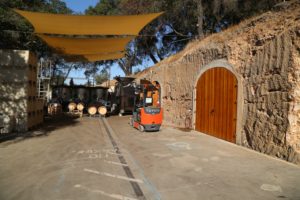
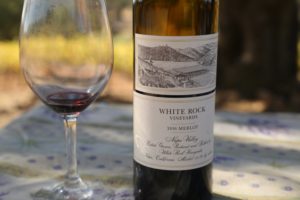
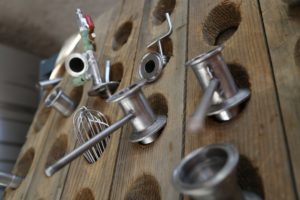 White Rock Vineyards is a small hidden winery typically not found on many Napa Valley winery lists or maps. Family run, their focus is about crafting limited-production, food friendly and balanced wines. Tours and tastings are offered on a limited basis for serious wine enthusiasts.
White Rock Vineyards is a small hidden winery typically not found on many Napa Valley winery lists or maps. Family run, their focus is about crafting limited-production, food friendly and balanced wines. Tours and tastings are offered on a limited basis for serious wine enthusiasts.
Modern day White Rock Vineyards was founded by Henri and Claire Vandendriessche. Claire is originally from Napa Valley; she used to teach French classes at the Napa College’s up valley campus in St. Helena. Her father also used to teach at Napa College (English, math and history). Henri, born and raised in the Loire Valley of northern France, moved to California to study economics at UC Berkeley in 1960 and is also where he met Claire. After they moved to Paris for a short while, they returned to California.
In the mid 1970s for three years, he and Claire looked for property in the Napa Valley – focusing their efforts on the western side of the valley. At one point Henri came close to purchasing land in Carneros. Several factors contributed to finding this property – his father-in-law mentioned this particular piece of land was for sale and Henri also saw it listed in the paper. Originally this was part of a much larger land grand owned by Salvador Vallejo (brother of Mariano Vallejo, the namesake of the town of Vallejo).
Henri and Claire purchased the 64-acre property in 1977. The original stone winery was still standing – built by vintner John Pettingill (a dentist originally from Massachusetts) in 1870 from rock hand-quarried from the property. It was Pettingill who chose the name, White Rock Cellar for his operation. His wines were estate grown – produced from 20 acres of Riesling that he planted.
Rather than reintroduce winemaking inside the original winery, Henri and Claire converted this old stone building into their family home. Unfortunately, in October 2017 the devastating fires in this part of the Napa Valley burned through their house – leaving only the stone walls still standing. Remarkably they lost only about 1/2 acre of vines (the edges of the vineyard) although they were one of the only producers in the valley who sustained damage within their cave. Several 1/2-ton plastic bins were stacked outside next to one of their cave entrances; the fire burned these so hot they turned into ash and caused the nearby wooden door to burn – the fire then entered the cave and destroyed about 1,000 cases of wine they were getting ready to ship out to club members.
All the vines had been pulled out by 1965. A well-known polo player from San Francisco had the vines replaced with a horse training facility. Henri planted vines in the late 1970s, sold fruit to other wineries for several years and ultimately started making his own wine – the first vintage of White Rock is from 1986 and for about 15 years, they only produced two wines each year, a Chardonnay and their Claret (a red blend). The first wine produced commercially from the Vandendriessche’s was actually in 1983 – for three years they bottled under the name Vandendriessche Vineyards.
Prior to the winery cave being completed, the wine was produced in a number of places including the first two vintages in the basement of the original stone winery (which Henri and Claire were living in by this time). And the cave has been used for winemaking by other clients over the years including housed the first production of Blue Heron Lake wines in 1985, the precursor brand to the still active Olivia Brion.
Henri is still very much involved in White Rock but today his two sons manage and run the winery operations. Christopher is the winemaker – he was at the University of Santa Cruz studying physics when he decided he wanted to focus on wine. He has significant international experience working at wineries for several years in France and later in Spain. He took over winemaking for White Rock in 1999). And Chris’s wife Sarah is also a winemaker in the valley.
His brother Michael (who lives on site) is the vineyard manager.
The Vineyard
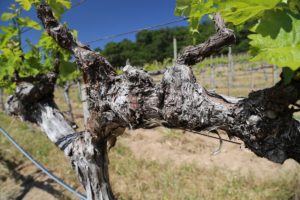 The property is tucked away, a ‘hidden’ part of Napa Valley located at the base of the Stags Leap District and features a diversity of hillsides above a small valley. The family planted Chardonnay in a lower section of the property (the coolest area – where the wind machines are located) and Cabernet Sauvignon on the hillsides. A small block is planted to several red varieties and is the source for their claret wine. In the 1970s few Napa Valley based vintners were making a wine from blended red varieties. Henri planted part of the vineyard to the red varieties with the intention of making a red blend. Whiterock Vineyards was the first in the Napa Valley to officially label a wine as a claret – a word that is associated with the British referring to fine wines made from Bordeaux red varieties.
The property is tucked away, a ‘hidden’ part of Napa Valley located at the base of the Stags Leap District and features a diversity of hillsides above a small valley. The family planted Chardonnay in a lower section of the property (the coolest area – where the wind machines are located) and Cabernet Sauvignon on the hillsides. A small block is planted to several red varieties and is the source for their claret wine. In the 1970s few Napa Valley based vintners were making a wine from blended red varieties. Henri planted part of the vineyard to the red varieties with the intention of making a red blend. Whiterock Vineyards was the first in the Napa Valley to officially label a wine as a claret – a word that is associated with the British referring to fine wines made from Bordeaux red varieties.
The soils here are very rocky yet crumbly and during the dry season the vineyard can be a very dusty place. About a foot of topsoil is on the hillside part of the vineyard and below this is a white volcanic rock called tufa or compressed volcanic ash. Vines have to truly work to force their roots down into the ground – finding cracks and other soft spots in this particular type of rock. The vineyards are all managed organically (no pesticides or herbicides).
The 25-acre vineyard is categorized by 49 separate vineyard blocks. And despite some of the blocks being so close to others, there are noticeable differences in the wines based on exposure, temperature and soil characteristics.
The Cave
Caves were dug in 1987 and true to its name, a sizable portion of the front of the caves were dug through chalky white volcanic rock. Parts of the cave are left raw (no gunnite), and one can easily see the white tufa. The cave also extends through a different type of rock that is very red iron rich and much harder than the tufa. Napa Valley wine cave pioneer Alf Burtelson, a general engineering contractor, oversaw the drilling of their cave.
Alf is well into his 80s now and long since retired although is still living in the northern part of Napa Valley. Henry had Alf excavate ten 4-5-foot-deep alcoves within the cave. These were not dug to house an art collection – rather they were specifically created for aging their red wines. Four sets of bottles are stacked tightly from the bottom of the cave to the top ultimately completely filling these alcoves with previous vintages of their wines.
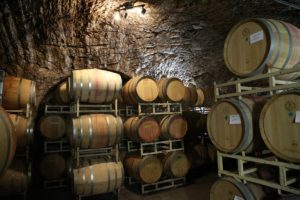 Each of these alcoves can hold between 4,000 to 6,000 bottles – and with the number of alcoves built into the cave, up to 45,000 bottles of wine can be stored at any one time. During the Napa earthquake in August 2014 White Rock lost no barrels of wine – however bottles equivalent to about 50 cases fell down from one of the alcoves – approximately 25 cases worth of wine actually broke. In all the years of wine making here, this has been the only damage to wine at the winery Henri has seen from an earthquake.
Each of these alcoves can hold between 4,000 to 6,000 bottles – and with the number of alcoves built into the cave, up to 45,000 bottles of wine can be stored at any one time. During the Napa earthquake in August 2014 White Rock lost no barrels of wine – however bottles equivalent to about 50 cases fell down from one of the alcoves – approximately 25 cases worth of wine actually broke. In all the years of wine making here, this has been the only damage to wine at the winery Henri has seen from an earthquake.
After visiting 1,100+ Napa wineries and producers to date, there is only one other winery in Napa Valley that uses this type of stacked bottle aging system for some of their wines, not all – and that is Far Niente. And the sparkling producer, Schramsberg ages their sparkling wines in this manner. For those who have never heard the sound made by fermenting wine, a number of years ago White Rock Vineyards creatively recorded an almost 3-minute audio. However, don’t expect a Pavarotti type performance.
Over the years this cave has been used by several small producers who rent out space to make their own wines. Perhaps the most prominent of these, was Hudson Vineyards who made their wine here before their own winery was built at their ranch in Carneros.
Select Wines
For many years White Rock specialized in Chardonnay, the Claret red blend and later a Cabernet Sauvignon. However, in more recent years they began producing several very small production wines from newer plantings in the vineyard of Syrah, Viognier and Malbec. These wines are usually only a barrel or two and all are made by hand using a small basket press. And the White Rock bottlings are all estate and are all 100% varietal.
Whites
White Rock vineyards produces some of the more intriguing Chardonnays coming from Napa Valley. And these are wines that can age more than most Napa Valley produced Chardonnays. Their primary Chardonnay is made in a Burgundian style including barrel fermented and barrel aged, but using only a small percentage of new French oak. Their Chardonnays are fermented using indigenous yeast as much as possible and the percentage of malolactic fermentation varies depending on the vintage.
The 2019 White Rock Vineyards Napa Valley Chardonnay is medium gold in color; the bouquet shows a medium intensity with an attractive union of both primary and secondary aromatics. It reveals scents of apricot, pineapple, banana, mango, butterscotch, warm butter (but this is not the dominating character), caramel, crème Brule and vanilla. This wine exhibits plenty of California sunshine, but shows a non contemporary Napaesque restraint, both on the bouquet and the palate. Its properly buckled in moving at a safe speed rather than unbuckled while recklessly driving. The palate sports flavors of kiwi, pineapple, Golden delicious apple, and some lingering citrus undertones. Its mid palate texture is somewhat fleshy which is balanced nicely by the bright acidity and resulting energetic finish. Looking for Napa Valley Chardonnay which has good aging potential? This wine is an ideal candidate.
The 2016 White Rock Vineyards Napa Valley Chardonnay is straw yellow in color; this wine offers aromas of citrus, melon, green apple and a minerality component. It retains excellent acidity, is crisp and clean and impeccably balanced across the palate. During its aging it is left on the lees and regularly stirred which gives it a slight weight and creamy texture. This is certainly not a style that is oak-driven or buttery.
The 2019 White Rock Vineyards Breccia Chardonnay Napa Valley is deep gold in color; the bouquet sports a generosity and diversity of aromas including ripe pineapple, Golden delicious apple, caramel, honeysuckle, crème Brule, apricot, butterscotch, hazelnut and vanilla. The sweetness of baking spices dominate; there is nothing shy about the nose and it shows plenty of California sunshine. Equally as rich across the palate, this wine offers flavors of apple, pear, apricot, pineapple, yellow peach, yellow nectarine and ripe mango. There is simply ‘more’ going on with this particular bottling of Chardonnay as compared to the same vintage of their Napa Valley bottling. Its intensity of flavor and fleshy texture are countered nicely by its lively and refreshing acidity. This wine sports a long, rich and satisfying fruit filled finish. Bright. This wine was aged entirely in once-filled French oak barrels and is a bottling that shows elements of oak without being overly oak influenced. It was age sur-lies in for 18 months.
The 2016 White Rock Vineyards Breccia Chardonnay went through 50% malolactic fermentation. The bouquet offer aromas of green apple, gooseberry and floral notes including honeysuckle and citrus. There is a noticeable intensity of fruit across the palate with a parallel of perceived sweet fruit complemented nicely by bright acidity. This is a beautiful showing of a rich but balanced and bright Chardonnay and is a wine well worth seeking out.
Another extremely limited production White Rock produced Chardonnay is their reserve in which about half the wine is allowed to undergo full malolactic fermentation and half goes through primary fermentation. And utilizing the services of Brut Bottling in the city of Napa, White Rock produces sparkling wines from Chardonnay. Brut Bottling provides a variety of sparkling wine services for wineries who do not have the equipment to make sparkling wines.
Reds
The 2019 White Rock Vineyards Cabernet Sauvignon is deep ruby; the bouquet is not shy and immediately offers aromas of dark plum, blackberry, dark raspberry, bramble, leather, old cedar box, light tonka bean, tobacco spice and lightly roasted coffee beans. The bouquet smells fresh and savory. Balanced across the palate between acidity, flavor, barrel influence and texture, the one word we noted to describe these simultaneous characteristics was seamless. It offers flavors of red plum, cherry, currant and raspberry. The bright red-fruited finish lingers with grainy tannins accompanied by a dark lingering spice note including of cedar and a persistent drying chalky character. This wine has plenty of life ahead of it with proper cellaring. We We coravined this wine like we do for most of our tasting notes, but we will definitely save the rest of the bottle for a juicy T-bone steak on the BBQ.
The 2019 White Rock Vineyards East Bench Cabernet Sauvignon is deep ruby in color; the bouquet is immediately generous with its core of fruit including aromatics of ripe plum, blackberry and dark fruited preserves along with lighter notes of cedar, chocolate and vanilla. A sweetly fruited thread also runs through the nose including scents of fig and cooked blackberry. This wine sports flavors of dark cherry, blackberry, black plum and blueberry. If we were to choose one word to describe the cadence of this wine’s long finish, it would be seamless. The tannins display what we call the three R’s of integration; they are ripe, resolved and rounded, and in this bottling in particular, show more on the front of the palate than the back. And if we were to choose one word, albeit a generic one, to summarize its overall appeal, it would simply be delicious.
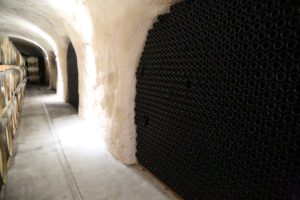
 The Claret is a blend of Cabernet Sauvignon, Cabernet Franc, Merlot and Petit Verdot and is barrel aged for up to 2 years, then bottle aged for up to two more years so by the time it is released, it has had 4 years of aging. Very few Napa Valley wineries have the luxury of aging a wine this long. The Claret blend typically changes each year, but Cabernet Sauvignon is always the majority variety. The 2016 White Rock Vineyards Claret has an appealing bouquet dominated by fruit including plum with undertones of dust and tobacco leaf. Offers flavors of blackberry with a noticeable density of tannins on the finish. Firm, dusty but still finely polished in texture. Drinks very well by itself.
The Claret is a blend of Cabernet Sauvignon, Cabernet Franc, Merlot and Petit Verdot and is barrel aged for up to 2 years, then bottle aged for up to two more years so by the time it is released, it has had 4 years of aging. Very few Napa Valley wineries have the luxury of aging a wine this long. The Claret blend typically changes each year, but Cabernet Sauvignon is always the majority variety. The 2016 White Rock Vineyards Claret has an appealing bouquet dominated by fruit including plum with undertones of dust and tobacco leaf. Offers flavors of blackberry with a noticeable density of tannins on the finish. Firm, dusty but still finely polished in texture. Drinks very well by itself.
The White Rock Cave Hill Cabernet Sauvignon is not made every year – this very terroir specific wine is 100% varietal Cabernet Sauvignon sourced from a tiny 1/2 acre block – one of the most premium vineyard blocks on the property. The site was formerly an apricot orchard. As Henri says, “it finally became obvious I would never eat a ripe apricot from this orchard,” (due to the birds and other wildlife eating the fruit before it was fully ripe) so he decided to finally remove the trees and plant grapes.
Originally a high school project for Chris and Michael – the two boys planned and planted the vineyard (doing all the work themselves from pounding in the end posts to the trellising). Henri asked them if they wanted to be paid for their work once the vineyard planting was completed or if they wanted to share in future profits. Wisely they elected the latter.
All of their red wines tend to be very age worthy.
And in a partnership with Fatted Calf in the city of Napa, White Rock supplies a limited amount of wine that is used to flavor what is sold as the White Rock salami.
—
Tastings are hosted for small groups, typically 2-6 people and include a visit to both their vineyard and cave. Plans call for excavating the hillside to one side of their cave for building a permanent tasting room and also for a small parking lot. To purchase wine online, to join their wine club, to schedule a visit to the property or for more information visit: www.whiterockvineyards.com
Outdoor/Vineyards
Cave






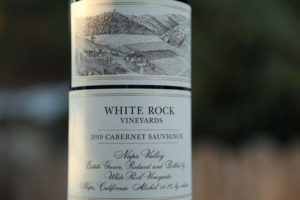
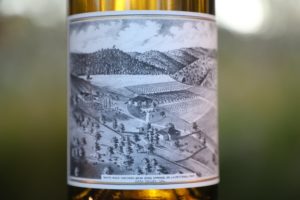
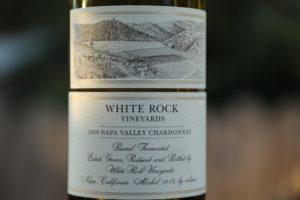
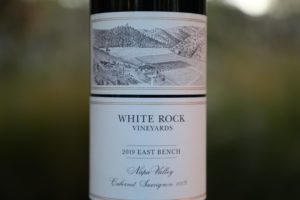

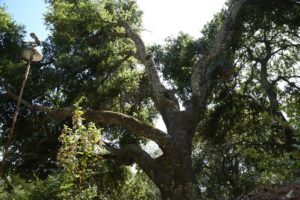
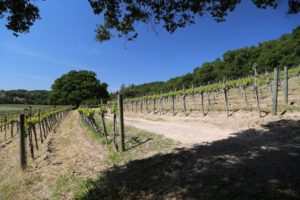
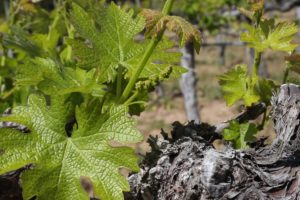
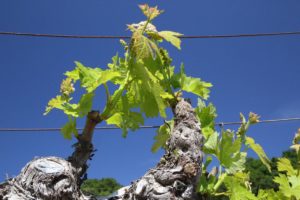
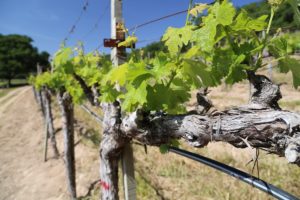
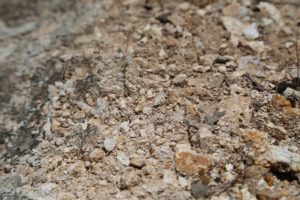
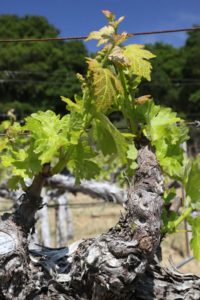
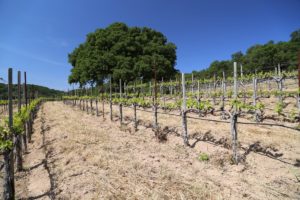
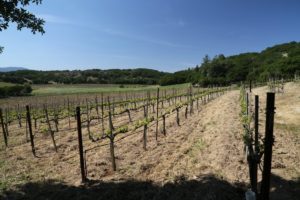
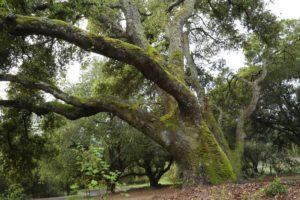
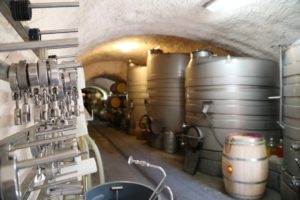
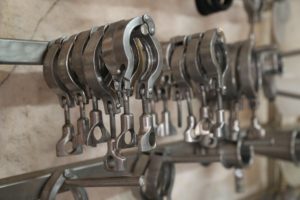

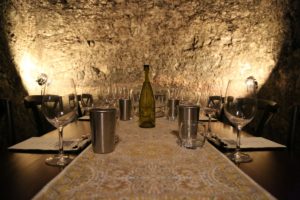
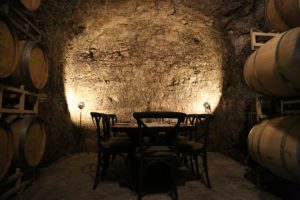
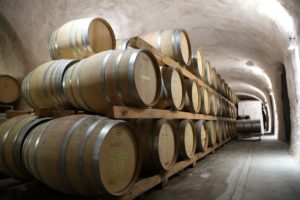
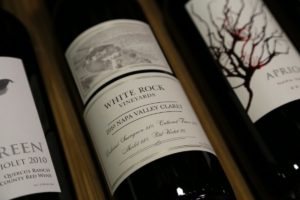
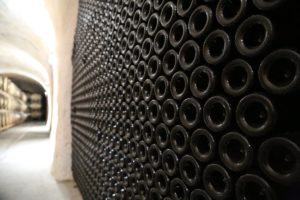
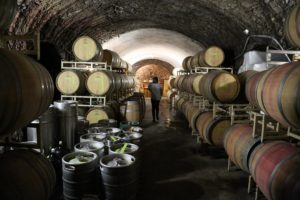
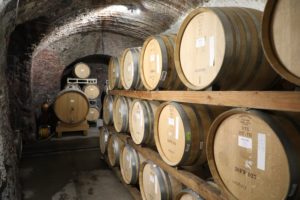
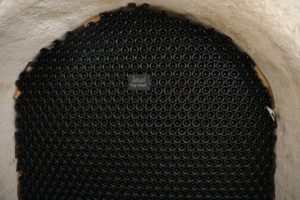
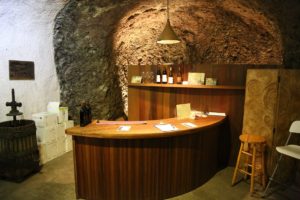
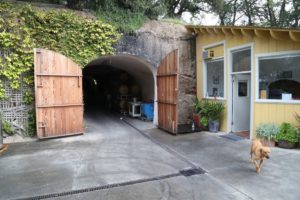
Hi Michael,
We had a wonderful tour of your winery with you Saturday morning, May 23rd with our son Behren Aydt and his girlfriend Emily Cox. This was the first time I actually liked a red wine and I wanted to send a bottle to my brother-in-law and sister. Unfortunately, I do not remember what we tried. I was hoping you would remember and I could order a bottle to be sent to my brother-in-law for his birthday. He lives in Guttenberg Iowa, I hope you can ship there.
I so enjoyed our visit to your winery.
Sincerely,
Samantha Aydt
Samantha – glad to hear you had a great experience at White Rock Vineyards – it is a special place 🙂 I was just there 2 days ago. I’ve passed your note on to Terra Jane who will follow up.
We are all hoping for a speedy recovering from the Atlas Peak Fire – this has been devastating to a number of homes and wineries including White Rock Vineyards.